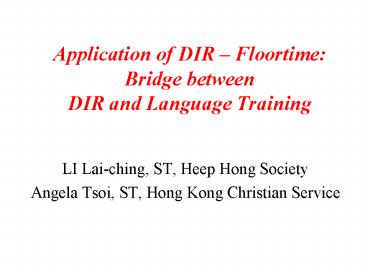Application of DIR - PowerPoint PPT Presentation
1 / 20
Title:
Application of DIR
Description:
... pragmatics, and receptive and expressive language (Greenspan and Lewis, 2005, p.3) D2: 36-48 months D1: 24-36 months C: 16-24 months B: 9-16 months A: ... – PowerPoint PPT presentation
Number of Views:143
Avg rating:3.0/5.0
Title: Application of DIR
1
Application of DIR Floortime Bridge between
DIR and Language Training
- LI Lai-ching, ST, Heep Hong Society
- Angela Tsoi, ST, Hong Kong Christian Service
2
Bridge between DIR and Language Training
- 1/ The DIR model and language development
- 2/ Affect-Based Language Curriculum (ABLC)
3
1/ The DIR model and language development
Sherri Cawn, M.A., CCC-SLP Cindy Harrison, M.Sci.
Functional Emotional Development Stages
Language Development
4
Functional emotional stage Age reference Communication/ Language development
1. Attention and regulation 0-3 months Co-regulation and communication
2. Engages in relationships 3-6 months Back-and-forth exchange
5
Functional emotional stage Age reference Communication /Language development
3. Two way, purposeful interaction with gestures 7-9 months Open and close circles An active partner More comprehension More vocalization
4. Purposeful problem solving interaction 9-18 months Sharing meanings in gesture and words Use of gestures (e.g. pointing) First word
6
Functional emotional stage Age reference Communication /Language development
5. Elaborating ideas 24-36 months Use of abstract representational systems Symbolic play development - play out intentions Word combination - increased utterance length and content
7
Functional emotional stage Age reference Communication /Language development
6. Building bridges between ideas 36-48 months Sequences of symbolic actions Conversation skills
8
Affect and Language development
- Affect is more critical for many elements of
language acquisition and use than has been
traditionally realized. (Greenspan and Lewis,
2005, p.3) - The more you interact with affective gesturing
the more differentiated your interactions are.
The better it will be when words and sentences
appear. - Affect gesturing ? pointing ? complex
gestures/causality
9
Social Communication
10
A DIR/Speech Therapist
- Engaging and interactive
- Believes that product is less important than
process - Understands that expressive language is not
always the goal - Focuses on gestures as an important part of
treatment - More than words
11
A DIR/Speech Therapist
- Understands the link between emotional
development, speech and language, and regulation - Utilizes floortime/play based intervention
- Recognizes individual differences!!!
12
2/ Affect-Based Language Curriculum (ABLC)
- Background of ABLC
- Authors Stanley I. Greenspan, MD Diane Lewis,
MA, CCC/SLP - A curriculum for speech therapy
- Integrate AFFECT and LANGUAGE together
13
- Hypothesis
- Affect and engagement are fuel to drive the
development of language - Create heightened affect states
- Utilize affect and engagement with pleasurable
back-and-forth reciprocal interactions as the
foundation for the development of imitation,
pragmatics, and receptive and expressive
language (Greenspan and Lewis, 2005, p.3)
14
Greenspan and Lewis (2005) p.5
15
D2 36-48 monthsD1 24-36 monthsC 16-24
monthsB 9-16 monthsA 0-9 months
Core areas
Co-regulated reciprocal interaction
Expressive Language
Receptive Language
- Engagement
Pragmatics
Imitation
Levels
16
ABLC - Subject selection
- Child VS Adult
- Best to apply during childhood
- For clients functioning at about 0-48 months
- Apply on clients with special needs
- Autistic Spectrum Disorders
- Mental Retardation
- Seizure Disorders
17
ABLC - Implementation
- Assessment
- Using checklist as a screening
18
ABLC - Implementation
- Treatment
- Using schedule on recommendation of combination
of treatment - Sensory Preparation - Systematic Instruction
- Applied Floor Time - Oral-motor
program - AAC
- Using systematic instruction tracking form for
goals setting and recording
19
ABLCExamples on skills targeted
- Level A
Engagement Engage and shares attention with the adult and /or objects used by the caregiver for 10 seconds Take the initiative to vocalize to get your attention
Imitation Responds to the adults sound with sounds of his or her own Imitates the adults facial expression
Receptive Responds to a sound that is not visible Appears to listen to the speaker
Expressive Smiles responsively with an adult Responds vocally when called by an adult
20
ABLCFrequency and schedule
- Depending on childrens developmental needs and
overall program - Minimum of 1-1.5 hours each day on ABLC and other
recommended program - For children at lower level
- ?sensory preparation, oral-motor and floor time
- ?systematic instruction and applied floor time































